

The first plant most people think of when they hear the word 'orchid' is the Phalaenopsis. And with good reason. They are hardy plants, with phenomenal flowers, that can last for months. There is nothing not to love about this plant, and more and more people are discovering it's beauty. They are widely available in nurseries, home and garden, and grocery stores, and make wonderful gifts. A Phalaenopsis truly brings a small piece of the rainforest into your home. Luckily, Phalaenopsis orchid care is easy enough for beginners; if you follow a few simple orchid care instructions, your Phalaenopsis will thrive, and reward you with beautiful flower spikes year after year.
Phalaenopsis care is fairly typical to other low-light epiphytic orchids. They are extremely popular and their care is certainly not difficult compared to many other more delicate orchid varieties. The many hybrid Phalaenopsis for sale in stores offer some of the most attractive and easiest orchids available, and make an excellent choice for the new orchid grower. The blooms can last for several months and with care, Phalaenopsis orchids can bloom more than once a year. But do take care - Phalaenopsis orchid requirements are quite different from typical rooted houseplants, and to understand why, we need to consider the plants natural life in moisture of a tropical rainforest.
Phalaenopsis is the name of a genus in the orchid family Orchidaceae. There exist about 60 known species of Phalaenopsis orchid, and a broad collection of different hybrids. Phalaenopsis orchids are sometimes referred to as “Moth Orchids”, because the flowers look like large tropical butterflies. Wild Phalaenopsis orchids are epiphytes: that is they grow on tree branches (and sometimes stones, in which case they are more correctly termed lithophytes), and are usually found below the canopy in humid lowland forests. They do however also occur in habitats exposed to dry and/or cool seasons. Phalaenopsis orchids are native to Asia and Australia. In Asia, they are found from the Himalayan mountain range to the Philippines. In Australia, they grow only in the northern parts of the continent.
To demonstrate correct Phalaenopsis care indoors, it is useful to consider how their natural environment as an epiphyte differs from that of a typical rooted houseplant. Epiphytic plants are those that grow attached to other plants. Their relationship is not parasitic: they do not steal nutrients from the host plant, merely use it as a substrate on which to grow. They do not root into the ground, and are therefore limited to whatever water and nutrients fall onto them. Epiphytes use their roots to cling on tight, and to absorb these nutrients. But they have another use too, epiphytic roots are able to perform photosynthesis - something typical planted species can not. Because they are unable to take water from the ground, these epiphytes are typically found in very humid rainforests, allowing them to take water from the air. Even after a prolonged downpour, the plant will quickly dry out: the combination of tropical heat, and the ventilation provided by their positioning means that plants are never wet for long.
Care for orchids indoors doesn't have to involve pots - elaborate displays in warm greenhouses can include Phalaenopsis growing epiphytically as shown here. Plants that are wired into place will gradually take hold - a wonderful way to take care of Phalaenopsis orchids.
Obviously it is not possible for many orchid growers in temperate zones to replicate precisely the conditions for Phalaenopsis in the wild. But Phalaenopsis orchid care can be really simple. Unfortunately, many people receiving an orchid as a gift will treat the plant the same as any other houseplant. It may be placed on a saucer, watered, and allowed to sit with it's feet wet. The rots will soon rot. Unfortunately this is the best way to kill any epiphytic orchid.
When it comes to watering, you must exhibit extreme care, Phalaenopsis orchids indoors will never do well in a soggy plant medium. The secret is to water these plants often, but typically over a sink (or whilst hanging in a greenhouse), so that all water drains away. The plant will have absorbed enough water, but the roots will be able to dry out fairly easily. How often you will need to water your Phalaenopsis will depend on your local climatic conditions, and where your plant is kept. But there are two good ways to tell whether it is time to water your Phalaenopsis. Firstly check to see how moist the plants media is, an inch or two down. If there is no moisture it is probably ok to water. Secondly, look at the roots within the pot. An orchid with green roots is hydrated and does not need watering. If the roots are silver or grey, the plant will; appreciate a drink. If in doubt, skip watering - an over-watered orchid is in greater peril than an under-watered one. Phalaenopsis care becomes easier the longer you have had it, and the more you learn to read these roots. During normal indoor conditions, watering once a week will probably be enough, maybe twice per week in the heat of summer.
Insufficient watering will eventually harm the plant, but a lot more slowly than too much water. Leaves may appear floppy and withered. A sure sign the plant needs water!
This flower prefers the humid and moist air associated with the rainforest. To some extent this can be recreated with a simple plant mister, especially when the weather begins to get warm. Another simple method to raise the local humidity is to place the pot on a humidity tray. These look tidy, protect the surface upon which the plant sits, increase drainage (no water can get trapped beneath the pot), yet increases the plants access to water vapor. The use of a humidity tray can reduce the level of attention required from the owner. Very useful for orchid growers with hectic lives.
Phalaenopsis care is easiest when the orchid is in a special clear slotted pot. This is important for three reasons. Firstly, the slots (and bottom holes) ensure good drainage, making water logging much harder. Secondly, Phalaenopsis roots have the ability to photosynthesize - a clear pot allows light to get in. Thirdly, and perhaps most critically, the clear pots allow you to examine the plants roots. Aswell as checking general root health, you can immediately see whether your Phalaenopsis needs watering. Remember green roots are already adequately hydrated, silver roots are ready for watering. It is not essential to have a clear pot, the plant will do fine without one, and it may well have aerial roots anyway.
Most Phalaenopsis orchids are epiphytic, and some are lithophytic, however all Phalaenopsis suffer if they have “wet feet” - the media must be chosen with care - potted orchids must have media that is well draining - this is absolutely critical. Medium grade bark chips are a good choice, though bark mixes, with additional charcoal (keeps media fresher, longer) and sphagnum moss (increases moisture holding ability slightly) also work well. Sphagnum moss can retain significant water, and should be used sparingly in within the media.
The recommended day time temperature for Phalaenopsis orchids is 75-85° F (24-29°C), though slightly cooler temperatures are also tolerated. In general, a typical house will be just fine - these are not the most regularly seen orchids for nothing! Your orchid will appreciate cooler nights, though but the temperature should ideally stay above 60° F (15.5°C). A healthy and well-established Phalaenopsis orchid will typically handle occasional temperature extremes well, as long as the exposure is not prolonged. The bud is however much more sensitive than the rest of the plant. Excessively chilly temperatures can also make the orchid stop budding. Protecting your orchid from the cold is therefore an important part of proper Phalaenopsis orchid care.
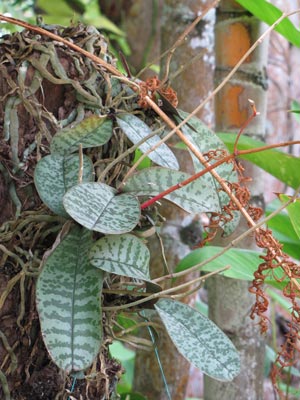 Phalaenopsis stuartiana growing as a lithophyte, on a wall in Hawaii. Photo Forest and Kim Starr
Phalaenopsis stuartiana growing as a lithophyte, on a wall in Hawaii. Photo Forest and Kim StarrPhalaenopsis are considered low-light orchids, but that does not mean they do not need light! You can take care of Phalaenopsis orchids in fairly average ambient lighting conditions; this is one of the reasons behind it's popularity as a house plant. It obviously appreciates diffused sunlight, but should not be subjected to direct summer sunshine. Wild Phalaenopsis orchids are usually found growing under vast canopies in lowland forests where they can remain sheltered from direct sunlight. Good Phalaenopsis orchid care will therefore involve protecting your plant from strong light, just indirect or reflected sun. The heat from too much sun exposure can easily burn the Phalaenopsis leaves. As with the roots, the color of the leaves tells us everything we need to know about each plants lighting needs. A happy leaf will be bright green in color. With insufficient light, the leaves will start to turn dark green, and flowering may also be impeded - either reposition your orchid nearer a window, or consider adding some artificial lighting. Leaves of plants that get too much light will turn yellow, red or even black in places - reposition your orchid away from the window, or add a screen or thin netting to protect the plant from the sun's heat.
Like all plants, orchids need nutrients to grow and to produce flowers. Fertilizing Phalaenopsis orchid must be performed by diluting feed into water, and simply pouring through the plant, as with watering. The plant will absorb all the nutrients it needs in this water. The best fertilizer for orchids will typically be a high-nitrogen liquid; any formulae developed specifically for orchids will work well. (I like Orchid Love)
A good approach to feeding epiphytic orchids in general, and Phalaenopsis in particular, is to feed them small amounts often. It is a really good idea to split the required monthly dosage into four and feed it weekly, rather than all in one go.
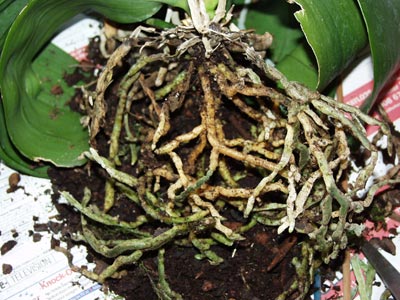 Periodic repotting is an important part of looking after a Phalaenopsis orchid
Periodic repotting is an important part of looking after a Phalaenopsis orchidTo keep orchids growing, planting in new media every two years or so is strongly advisable. It is important to do this, as the media does degrade over time. The best moment to repot is after the plant has finished flowering, however, if the media has become anaerobic, or turned mouldy, it should be repotted immediately.
Repotting is as simple as removing the plant from it's pot, gently teasing out the old media, possibly with the help of a little rinsing, and replacing in a new pot, (perhaps one size larger, assuming the plant has grown) with new media gently sprinkled in to fill the gaps.
It is a good idea to take care of orchid root health when repotting. Dead and dying roots will decay and can sour the media. Dead roots will typically be stringy, or mushy - quite different in texture to all the other healthy roots. Not firm at all. Anything dead should be cut away, without damaging the healthy roots. Repotting will always cause some damage; it just has to be minimised.
The media should not be pressed in tightly, as this can damage the roots. The orchid should not be planted too deeply either - the tops of the roots can be exposed, and any aerial roots should remain in place outside the pot.
Some people suggest watering sparingly after repotting, until the new roots have settled down somewhat. If you are repotting after flowering, the plant may well be ready for a dormant period with reduced watering anyway.
As long as Phalaenopsis is healthy and has adequate light it will flower. If your orchids leaves are dark green, your orchid most likely needs more light. Either reposition closer to a window - being careful to avoid the heat of direct sun, or install an LED growlight to boost it's current lighting.
But like the rainforest itself, orchids are somewhat seasonal. Usually, following flowering, our Phalaenopsis will slow down a little. Leaves will stop growing, and the plant will enter a period of dormancy for a month or two. At this point, many new orchid owners will fear the worst.. but everything is fine. Watering should continue sparingly, but not fertilizing, and the plant can be briefly moved to a slightly cooler part of your home for a week or more. But then growth will resume, new leaves and flower spikes will emerge.
Trimming orchids after blooming can encourage further flowering. A flower spike can be left to wither away; it can be removed completely with scissors, or it can be cut 2-3 nodes up, in the hope that it will re-flower. Whilst this is completely possible, it does force the plant into the position of using up valuable energy, and stored nutrients. Unless your Phalaenopsis is extremely vigorous, it might be better to wait for new blooms next season.
As can be seen below, the Phalaenopsis flowers come in the most wide range of beautiful colors, delicate shapes, and striking patterns.
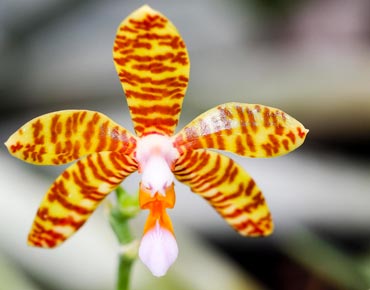 Phalaenopsis fasciata. Photo Quadrans
Phalaenopsis fasciata. Photo Quadrans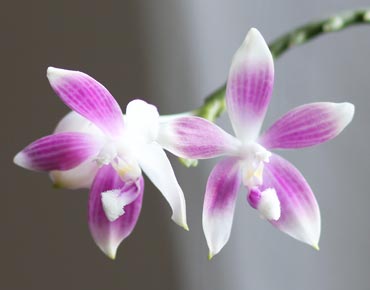 Phalaenopsis tetraspis. Photo Maja Dumat
Phalaenopsis tetraspis. Photo Maja Dumat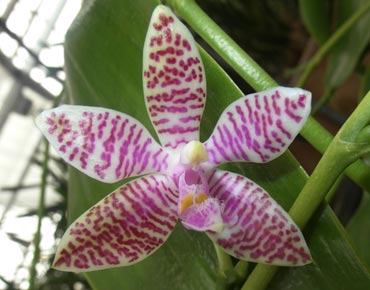 Phalaenopsis lueddemanniana. Photo Felix
Phalaenopsis lueddemanniana. Photo Felix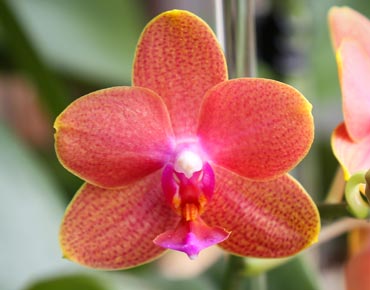 Photo Maja Dumat
Photo Maja Dumat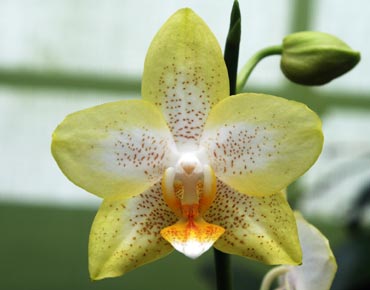 Phalaenopsis tetraspis. Photo Quinn Dombrowski
Phalaenopsis tetraspis. Photo Quinn Dombrowski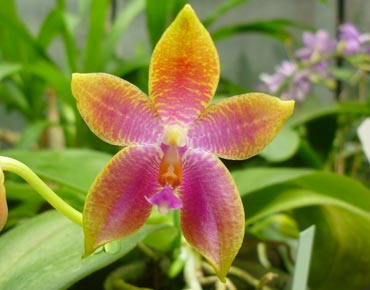 Phalaenopsis Penang Girl x (javanica x Coral Isles). Photo Felix
Phalaenopsis Penang Girl x (javanica x Coral Isles). Photo FelixPhalaenopsis are some of the most interesting orchids, with a huge variance in color, size and shape. Have a look at some of these rare and not-so-rare Phalaenopsis orchids for sale